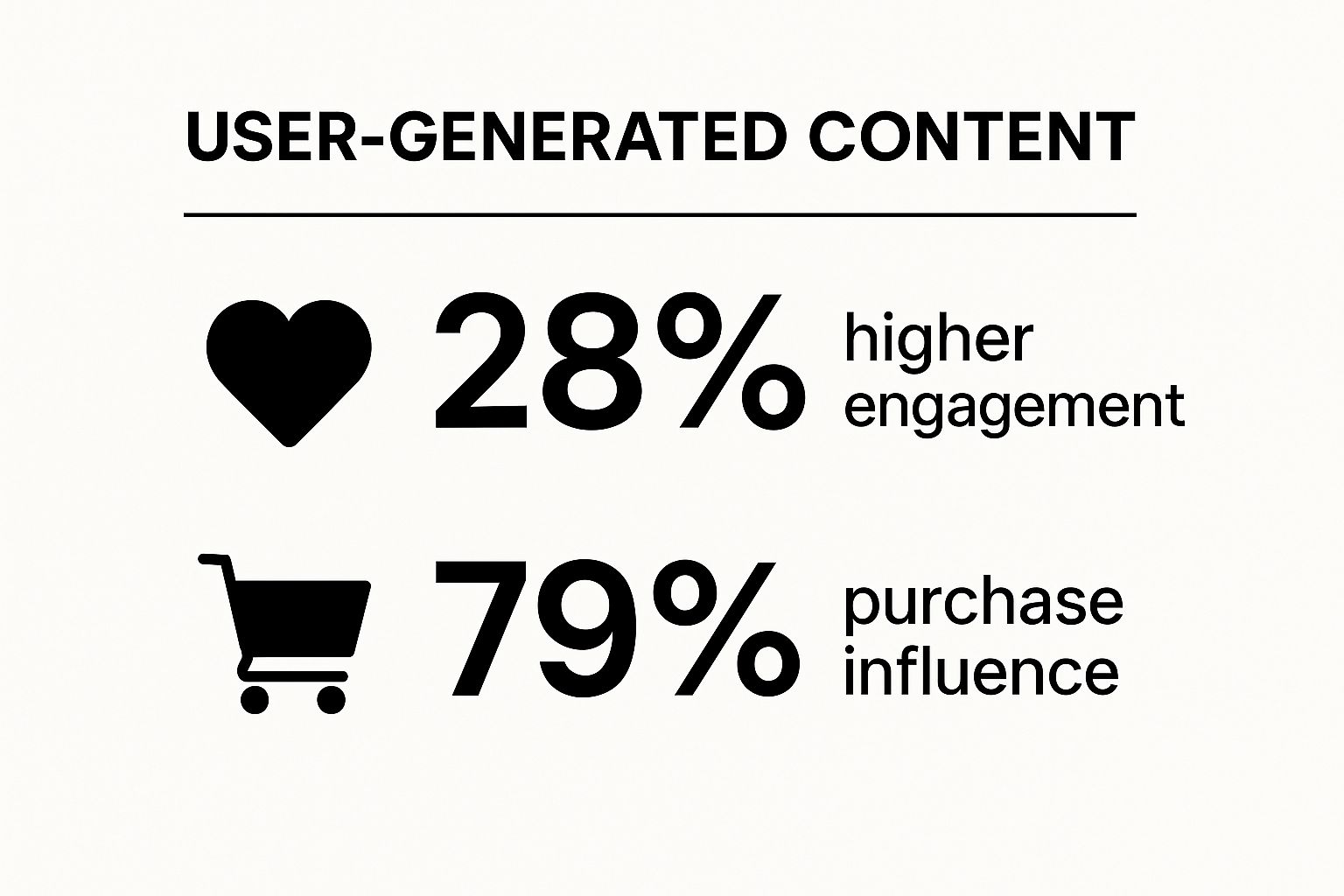In today's crowded online marketplace, a reactive, 'post and pray' approach to social media is a recipe for wasted resources. True success lies not in simply being present, but in executing a deliberate, well-crafted plan. But what does a winning strategy actually look like in practice? This article moves beyond abstract theories to dissect real-world social media strategy examples from innovative brands across various sectors. We're not just showing you what they did; we're breaking down the 'what,' 'why,' and 'how' behind their triumphs.
You'll get a detailed blueprint for each approach, from fostering user-generated content and building authentic communities to executing razor-sharp real-time marketing. To develop an effective blueprint, it helps to start with a manageable framework, like a concise 15-minute social media formula designed for impactful results.
Our goal is to provide you with a strategic toolkit. For each example, we'll provide actionable takeaways you can adapt, whether you're a local business in East Anglia or a growing eCommerce brand. These insights will equip you to build a social media presence that not only engages but also drives tangible business growth. Let's explore the strategies that turn followers into customers.
1. User-Generated Content (UGC) Strategy
A User-Generated Content (UGC) strategy pivots away from brand-created advertising and instead encourages your customers to become the content creators. This approach leverages the authenticity of real user experiences to build trust, community, and social proof. By incentivising followers to share photos, videos, and stories featuring your products or services, you can generate a powerful and continuous stream of genuine marketing material. This is one of the most effective social media strategy examples for building an engaged community.
Strategic Breakdown
Global brands like Starbucks with their #RedCupContest and GoPro with their customer-shot adventure videos have masterfully demonstrated the power of UGC. These campaigns don’t just sell a product; they invite customers into a shared experience, turning a simple purchase into a creative act. The strategy works by transforming passive consumers into active brand advocates, whose authentic content is often more persuasive than traditional advertising.
This approach is highly effective for businesses of any size. It fosters a sense of community, significantly boosts engagement, and expands your organic reach as users share content with their own networks. The key is to make participation easy, rewarding, and fun.
Actionable Takeaways for Your Business
To implement a successful UGC strategy, consider these steps:
- Create a Clear Campaign Hashtag: Develop a unique and memorable hashtag (e.g., #MyBrandStory) to track submissions and build a cohesive campaign identity.
- Offer Compelling Incentives: Motivate participation by offering prizes, discounts, or the chance to be featured on your official social media channels.
- Set Clear Guidelines: Establish simple rules for content submission and a clear moderation process to ensure all shared content aligns with your brand values.
- Engage and Amplify: Actively like, comment on, and share user submissions. This rewards participants and encourages others to join in. Always secure permission before repurposing UGC in your official marketing materials.
The following infographic highlights key statistics that underscore the power of UGC in driving engagement and influencing consumer behaviour.

These figures demonstrate that content from real users not only captures more attention but also has a direct and significant impact on the purchasing decisions of their peers.
2. Influencer Partnership Strategy
An Influencer Partnership Strategy involves collaborating with social media influencers to promote your brand, products, or services to their dedicated followers. This approach leverages the trust and credibility that influencers have built with their audience, turning their authentic recommendations into powerful marketing endorsements. Instead of broadcasting a message to a wide, undefined audience, this strategy targets specific niches through a trusted voice, making it one of the most effective social media strategy examples for driving awareness and conversions.

Strategic Breakdown
Brands like Daniel Wellington and Gymshark have become famous for their mastery of this strategy. Daniel Wellington equipped thousands of micro-influencers with its watches, creating an omnipresent and aspirational brand image across Instagram. Similarly, Gymshark built its empire by sponsoring fitness athletes and creators, integrating its apparel authentically into the lifestyle of its target demographic. These campaigns work because they don't feel like traditional ads; they are presented as genuine lifestyle choices by respected figures.
This strategy is exceptionally powerful for reaching highly engaged and relevant audiences. It allows businesses to bypass ad-fatigue and connect with consumers through a source they already trust. The key is to find partners whose personal brand and audience demographics align perfectly with your own, ensuring the collaboration feels natural and valuable to their followers. For a deeper dive into integrating this into your overall approach, you can explore more on building a comprehensive social media marketing plan.
Actionable Takeaways for Your Business
To build an effective influencer partnership strategy, focus on these core actions:
- Prioritise Alignment and Engagement: Select influencers whose followers match your target customer profile. Favour those with high engagement rates over those with just a large follower count, as an engaged audience is more likely to act on recommendations.
- Build Authentic, Long-Term Relationships: Instead of one-off sponsored posts, aim to build lasting partnerships. This fosters deeper brand loyalty from both the influencer and their audience, leading to more genuine endorsements over time.
- Establish Clear Goals and Guidelines: Clearly define your campaign objectives (e.g., brand awareness, lead generation, sales) and provide influencers with a clear brief. However, allow for creative freedom so their content remains authentic to their style.
- Ensure Full Transparency: Always adhere to advertising standards by ensuring influencers clearly disclose their partnership with your brand (e.g., using #ad or #sponsored). This builds trust with consumers and ensures legal compliance.
3. Community Building Strategy
A Community Building Strategy is a long-term approach focused on creating and nurturing an engaged group around shared interests, values, or brand affinity. Rather than simply broadcasting messages, this strategy cultivates a space for two-way conversations and meaningful relationships. It transforms followers from a passive audience into an active, connected community where members feel a sense of belonging to both the brand and each other.
Strategic Breakdown
Brands like Peloton and Lululemon have excelled at this by creating ecosystems where the product is the gateway to a larger lifestyle and community. Peloton's leaderboards and group challenges foster a sense of friendly competition and shared achievement, while Lululemon hosts local fitness events, turning online connections into real-world relationships. This approach shifts the focus from transactions to interactions, building immense loyalty and brand advocacy.
This strategy is one of the most powerful social media strategy examples for long-term customer retention. It creates a powerful moat around your business, as community members are invested in the brand beyond just its products. By providing genuine value and a sense of connection, you build an audience that is not only loyal but also provides continuous feedback and support.
Actionable Takeaways for Your Business
To build a thriving community, consider these key actions:
- Define Your Community's Purpose: Clearly articulate what your community stands for. Is it for sharing tips, celebrating achievements, or connecting over a shared passion?
- Create Valuable, Discussion-Worthy Content: Post content that invites conversation rather than just consumption. Ask questions, run polls, and share behind-the-scenes content that makes members feel like insiders.
- Appoint Dedicated Community Managers: Have a person or team responsible for moderating discussions, welcoming new members, and keeping the conversation positive and on-topic.
- Recognise and Reward Active Members: Regularly feature top contributors, celebrate member milestones, and create special roles or perks for your most engaged participants. This is a core component for learning how to improve social media engagement.
- Listen and Adapt: Actively monitor conversations and solicit feedback from your community to guide your content, product development, and overall strategy.
4. Real-Time Marketing Strategy
A real-time marketing strategy involves reacting swiftly to current events, trending topics, or breaking news with relevant brand messaging. This dynamic approach requires agility and cultural awareness, allowing a business to insert itself into ongoing conversations to boost visibility and connect with audiences in a timely, impactful manner. It is one of the more advanced social media strategy examples, but highly effective when executed correctly.

Strategic Breakdown
This strategy's power lies in its immediacy and relevance. The most famous example is Oreo's "You can still dunk in the dark" tweet during the 2013 Super Bowl blackout, a post that was conceived and published in minutes. Similarly, fast-food chain Wendy's has built its entire social media persona on witty, real-time responses and commentary on competitors and pop culture, demonstrating how this approach can define a brand's voice.
These successes are not just about being quick; they are about being prepared. Brands that excel at real-time marketing have a deep understanding of their brand identity and a streamlined process for creating and approving content. The goal is to join a conversation naturally, adding value or humour rather than forcing a sales message, which makes the brand feel more human and culturally connected.
Actionable Takeaways for Your Business
To effectively implement a real-time marketing strategy, consider the following actions:
- Establish Clear Brand Guidelines: Define which topics are appropriate for your brand to engage with and which to avoid. This ensures your responses remain consistent with your brand values, especially during sensitive events.
- Invest in Social Listening Tools: Use tools to monitor keywords, hashtags, and trending conversations relevant to your industry and audience. This allows you to identify opportunities as they emerge.
- Create a Streamlined Approval Process: Speed is essential. Organise a simple, rapid-response workflow so that content can be created, approved, and published in minutes, not hours.
- Prepare for Opportunities: Develop content templates or have a creative team on standby during major planned events like award shows, sporting finals, or industry conferences.
5. Content Series Strategy
A content series strategy involves creating ongoing, themed content that followers can anticipate and engage with regularly. This structured approach moves beyond random posts, building audience habits and establishing a consistent brand presence through predictable, valuable content formats. By delivering a recurring series, you train your audience to look forward to your posts, increasing retention and fostering loyalty.

This method is one of the most powerful social media strategy examples for establishing authority and becoming a go-to resource in your niche. It allows you to explore topics in depth and showcase your expertise consistently over time.
Strategic Breakdown
Brands like Tasty have perfected this with their iconic top-down recipe videos, creating a format so recognisable it became synonymous with their name. Similarly, National Geographic's 'Photo of the Day' provides a daily dose of stunning imagery that its audience actively seeks out. These series work because they deliver consistent value in a familiar package, reducing the guesswork for followers and making engagement a habit.
This strategy is highly adaptable for businesses of any size. It simplifies content planning by providing a repeatable framework, ensuring you always have relevant material to share. The key is to create a series that is genuinely useful, entertaining, or inspiring to your target audience, making it a reliable part of their social media experience. Exploring various social media content ideas can help you develop a series that truly resonates.
Actionable Takeaways for Your Business
To implement a successful content series strategy, consider these steps:
- Choose a Relevant Theme: Select a theme that aligns with your brand's expertise and your audience's interests (e.g., 'Tip Tuesday', 'Behind-the-Scenes Friday').
- Maintain Visual Consistency: Use consistent branding, colours, fonts, and layouts for all posts within the series to make it instantly recognisable in a busy feed.
- Plan and Batch Create: Plan your series calendar well in advance and create content in batches to ensure a steady, reliable posting schedule.
- Encourage Audience Interaction: Ask questions, run polls, or invite followers to suggest topics for future instalments to make the series interactive and community-driven.
- Monitor and Evolve: Track the performance of your series. Pay attention to engagement metrics and audience feedback to refine and improve the format over time.
6. Social Customer Service Strategy
A Social Customer Service strategy transforms your social media accounts from purely marketing channels into dynamic support hubs. This approach involves proactively monitoring social platforms for customer questions, complaints, and feedback, and responding to them directly and efficiently. By integrating customer service with social media management, you can resolve issues in public view, demonstrating your commitment to customer satisfaction and building a reputation for responsiveness and care.
Strategic Breakdown
Brands like JetBlue and Spotify have become leaders in social customer service by treating their social channels as frontline support. JetBlue's Twitter team is famous for its rapid, helpful, and often witty responses to travel queries and issues. This doesn't just solve one customer's problem; it publicly showcases the airline's dedication to its passengers, turning potential PR crises into demonstrations of excellent service. This is one of the most powerful social media strategy examples for enhancing brand reputation.
This strategy is crucial in an era where customers expect immediate answers. It turns a reactive process into a proactive one, allowing you to manage your brand's narrative, mitigate negative sentiment before it escalates, and foster loyalty. The key is to be present, responsive, and genuinely helpful where your customers are already spending their time.
Actionable Takeaways for Your Business
To effectively implement a social customer service strategy, follow these key steps:
- Establish Clear Response Time Goals: Set an internal service level agreement (SLA) for responding to mentions and messages, such as within one hour, and stick to it.
- Train Your Team: Ensure your social media staff are trained in customer service best practices, including tone, empathy, and de-escalation techniques.
- Create Escalation Protocols: Develop clear procedures for handling complex or sensitive issues that require input from other departments.
- Move to Private Channels When Needed: Acknowledge issues publicly, but promptly move conversations involving personal data or complex complaints to a private channel like a direct message (DM).
7. Employee Advocacy Strategy
An Employee Advocacy strategy turns your internal team into your most powerful brand ambassadors. It involves systematically encouraging and enabling employees to share company news, content, and their own positive experiences on their personal social media profiles. This approach leverages the authenticity and extended reach of your employees' networks to humanise your brand, build trust, and amplify your marketing messages. It is one of the most credible social media strategy examples for enhancing brand reputation from the inside out.
Strategic Breakdown
Tech giants like Microsoft and Salesforce have long recognised that messages shared by employees receive significantly higher engagement than those from official brand channels. Salesforce's #SalesforceOhana culture is a prime example, where employees are actively encouraged to share their work life, creating a powerful, authentic narrative around the company's values and environment. This strategy works because it taps into the inherent trust people have in their peers over corporate advertising.
When employees share content, it comes across as a genuine recommendation rather than a paid promotion. This not only expands your organic reach but also strengthens your employer brand, making it easier to attract top talent. The key is to create a supportive framework that empowers employees without being overly prescriptive, allowing their genuine enthusiasm to shine through.
Actionable Takeaways for Your Business
To build an effective employee advocacy programme, consider these steps:
- Provide Clear Guidelines and Training: Equip your team with clear, simple social media guidelines. Offer brief training on best practices to ensure they feel confident and represent the brand appropriately.
- Create Easily Shareable Content: Develop a library of pre-approved content, such as blog posts, industry news, and company updates, that employees can easily access and share with one click.
- Recognise and Reward Participation: Acknowledge employees who actively participate. This can be through internal shout-outs, small rewards, or a friendly leaderboard to gamify the experience.
- Respect Employee Choice: Advocacy should always be voluntary. Make the programme appealing and beneficial, but never mandatory, to preserve the authenticity of their posts.
8. Viral Marketing Strategy
A viral marketing strategy focuses on creating content designed to be shared rapidly and organically across social media platforms. The goal is to generate exponential reach through user-to-user sharing, rather than relying on paid promotion. This approach hinges on producing highly engaging, emotionally resonant, or exceptionally clever content that viewers feel compelled to share with their own networks. This is one of the most powerful, albeit challenging, social media strategy examples.
Strategic Breakdown
Legendary examples like Dollar Shave Club’s launch video or the ALS Ice Bucket Challenge demonstrate the core principle of viral marketing: creating a moment or a message that transcends the product itself. These campaigns captured public imagination by being funny, inspiring, or participatory. The content was not just an advertisement; it was a cultural event that people wanted to be a part of and share.
The power of this strategy lies in its ability to achieve massive brand awareness and engagement at a fraction of the cost of traditional advertising. When a campaign goes viral, it builds its own momentum, creating a snowball effect of views, shares, and brand conversation. The key is crafting content that taps into universal human emotions or triggers a strong sense of curiosity and novelty.
Actionable Takeaways for Your Business
To harness the potential of viral marketing, consider these strategic steps:
- Focus on Strong Emotional Hooks: Create content that elicits a powerful emotional response, such as humour, awe, surprise, or joy. Dove's 'Real Beauty Sketches' campaign, for example, succeeded by tapping into deep-seated emotions about self-perception.
- Make Sharing Effortless: Ensure your content is easily shareable on all major platforms. Embed clear calls-to-action that prompt users to share, tag friends, or participate in a challenge.
- Time Your Release Strategically: Launch your campaign when your target audience is most active online to maximise initial visibility and give it the best chance to gain traction.
- Have a Follow-Up Plan: Virality can be fleeting. Prepare a plan to capitalise on the sudden influx of attention by engaging with new followers, directing traffic to your website, and nurturing the leads generated.
Social Media Strategy Comparison Table
| Strategy | Implementation Complexity 🔄 | Resource Requirements ⚡ | Expected Outcomes 📊 | Ideal Use Cases 💡 | Key Advantages ⭐ |
|---|---|---|---|---|---|
| User-Generated Content (UGC) | Moderate – needs active moderation and guidelines | Low to moderate – relies on customer participation | High engagement (+28%) and strong purchase influence (79%) | Brands seeking authentic trust and organic reach | Builds credibility, cost-effective, expands reach |
| Influencer Partnership | High – managing influencer relationships and compliance | High – costs for influencer fees and campaign management | Improved brand awareness, targeted reach, ROI ~$5.20 per $1 spent | Targeted campaigns with access to engaged audiences | Professional content creation, strong endorsements |
| Community Building | High – requires long-term management and moderation | High – dedicated community managers and resources | Loyal advocates, 90% higher retention, 5x lifetime value | Brands focused on long-term engagement & loyalty | Strong emotional connections, sustainable growth |
| Real-Time Marketing | Very High – demands agility, monitoring, and approvals | Moderate – investment in social listening and fast coordination | Up to 300% engagement boost, 35x sharing likelihood | Brands prioritizing cultural relevance and viral potential | High visibility, cultural relevance, viral reach |
| Content Series | Moderate – consistent scheduling and quality control | Moderate – content planning and production resources | 45% increased retention, 60% better brand recall | Brands aiming for predictable, habitual audience engagement | Builds brand authority and routine engagement |
| Social Customer Service | High – requires trained staff and response management | High – dedicated customer service teams and tools | 85% satisfaction rate, 71% expect <1-hour response | Customer support and reputation management | Immediate support, loyalty building, problem prevention |
| Employee Advocacy | Moderate – training and policy enforcement needed | Low to moderate – internal training and incentives | Reach increase by 561%, trusted 3x more than brand content | Companies boosting brand authenticity and internal engagement | Humanizes brand, cost-effective, expands reach |
| Viral Marketing | Very High – unpredictable, needs creative excellence | Moderate – content creation and seeding efforts | Massive organic reach (100M+), 1200% higher share rate | Brands seeking rapid awareness and emotional impact | Huge reach, high emotional connection, PR value |
From Examples to Execution: Building Your Winning Strategy
We've journeyed through a diverse landscape of powerful social media strategy examples, from the authentic engagement of User-Generated Content to the lightning-fast relevance of real-time marketing. These case studies from brands big and small are not just stories of success; they are strategic blueprints waiting to be adapted for your unique business needs. The path from observation to execution is where real growth happens.
The most potent takeaway is that there is no single "correct" strategy. A successful approach is never a one-size-fits-all template. Instead, it’s a dynamic blend of core principles tailored to your specific audience, industry, and objectives.
Core Principles for Your Strategic Foundation
Across all the examples we analysed, from community building to viral campaigns, several universal truths emerged. As you begin to craft your own plan, keep these foundational pillars at the forefront of your thinking:
- Audience-Centricity is Non-Negotiable: Every successful strategy began with a profound understanding of the target audience. They knew their followers' pain points, sense of humour, values, and language. Your first step must always be to listen before you speak.
- Value Precedes the Ask: Whether it was providing stellar social customer service, creating an entertaining content series, or empowering employees to share their expertise, value was always the primary offering. Focus on giving your audience something genuinely useful or enjoyable, and the engagement will follow.
- Authenticity Drives Connection: Consumers can spot inauthenticity a mile away. The most resonant strategies showcased a genuine brand personality, whether through the unfiltered voices of customers (UGC), the passion of employees, or a consistent and transparent brand voice.
- Consistency Builds Momentum: A one-off viral hit is exciting, but sustainable growth comes from consistency. This applies to your posting schedule, your brand messaging, and your commitment to engaging with your community day in and day out.
Your Actionable Next Steps
Feeling inspired is a great start, but turning that inspiration into a tangible plan is what truly matters. Don't just admire these social media strategy examples; use them as a catalyst for action. Here’s how you can begin transforming these insights into your own winning formula:
- Conduct a Strategic Audit: Review your current social media presence. Which of the strategies we've discussed aligns most closely with your brand's strengths and your audience's behaviour?
- Define Your Primary Goal: Are you aiming to build a community, drive sales, enhance customer service, or increase brand awareness? Choose one primary objective to focus your efforts initially.
- Select and Adapt One Strategy: Don't try to implement everything at once. Choose one core strategy, like developing a content series or launching a small-scale influencer partnership, and commit to executing it well. Adapt its core tactics to fit your brand and resources.
Ultimately, a masterful social media strategy is a powerful engine for business growth, fostering loyalty and driving tangible results. It requires creativity, analytical thinking, and a persistent dedication to your audience. By internalising the lessons from these diverse examples and applying them with focus and consistency, you can build a vibrant online presence that not only captures attention but also creates lasting value for your business.
Ready to move from theory to reality but need an expert partner to guide you? The team at Ibertech Solutions Limited specialises in crafting bespoke digital marketing and social media strategies for businesses across East Anglia. We can help you analyse, plan, and execute a powerful strategy that delivers measurable results. Visit Ibertech Solutions Limited to learn how we can build your winning online presence.





